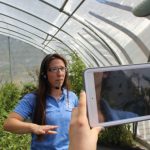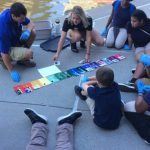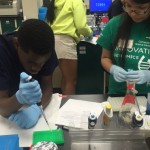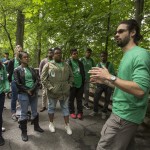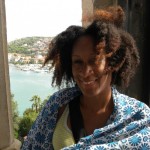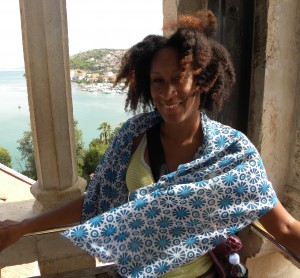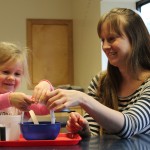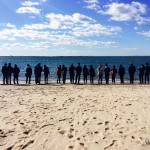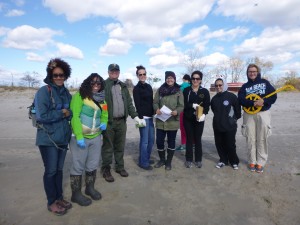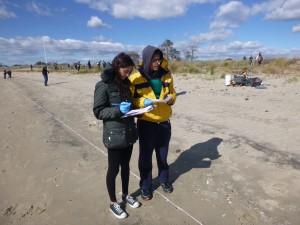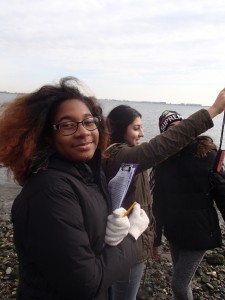Category Archives: Partnerships
SENCER-ISE University of Connecticut and Connecticut Science Center Partnership Featured on CAISE Blog
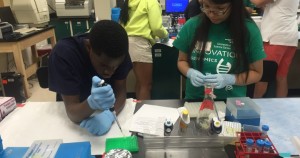
Photo credit: Stephanie Airoldi
The partnership between the University of Connecticut and the Connecticut Science Center, supported by SENCER-ISE, has been featured in the CAISE (Center for Advancement of Informal Science Education) Perspectives Blog as part of its Museum/University partnership series.
Rachel O’Neill, professor and head of Genetics and Genomics at the University of Connecticut, and Hank Gruner, Vice President of Programming at the Connecticut Science Center are partnering to increase genomic literacy.
Learn more about University of Connecticut and Connecticut Science Center’s goals, challenges, future plans, and more in their blog post.
Fordham University and Wildlife Conservation Society Partnership Featured on CAISE Perspectives Blog
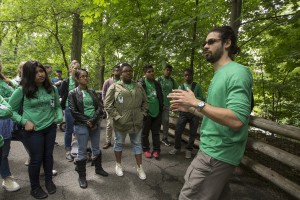
NYC high school students learn about urban ecology from a Fordham University student. Photo credit: Bud Glick
The SENCER-ISE partnership between Fordham University and the Wildlife Conservation Society is featured on the CAISE (Center for Advancement of Informal Science Education) Perspectives blog. The partners discuss their collaboration on Project TRUE: Teens Researching Urban Ecology, which uses a tiered-mentorship model to introduce New York City high school students to urban ecology and increase the rate of students pursuing STEM majors by facilitating collaborations with college mentors already in STEM disciplines.
Continue reading to lean more about the Fordham University and the Wildlife Conservation Society’s partnership and Project TRUE.
This is the third installment of SENCER-ISE’s mini-Spotlight series as CAISE continues to highlight university and museum collaborations. Click to read previous posts about the SENCER-ISE initiative, and the Cornell University and the Sciencenter partnership.
Professor Jennifer Adams on the Benefits of Informal Science and Place-Based Education
Jennifer D. Adams, an associate professor of Science Education and Earth and Environmental Sciences at Brooklyn College and one of the co-investigators for the SENCER-ISE supported project, Sentinels of Shoreline Change, was recently featured in Brooklyn College Magazine’s issue on “Women Who Shape the World”, a broad-ranging article on social and academic challenges faced by girls and women. In the article, featured on page 14, Adams points to the Lang Program, a seven-year extracurricular program for students from the fifth through twelfth grade offered through the American Museum of Natural History. The program engages students in learning science in “hands-on” classroom settings, and through research projects and career exploration. Adams helped initiate the program around the year 2000 and has examined the benefits participation in Lang brings to students, especially to young women. She concludes that, “the spaces where a lot of young women are finding their scientific voices are these out-of-school learning activities.”
In response to our questions about her work, Adams recently placed her involvement with the Lang program in the context of the role of informal education and its links to the more formal classroom:
What is your teaching specialty at Brooklyn College, within the science education program?
My specialty is informal science education and place-based education. I focus both on educating teachers to use out-of-classroom resources to teach and learn science and also students who are interested in being educators or researchers in informal science settings.
You note that “out-of-school experiences tend to yield better results in terms of inclusivity of young women and girls” and offer opportunities for students to learn more about different career options in the sciences. How can a project such as your SENCER-ISE one provide tools to classroom teachers to encourage students in science? Can such a model be used in teacher education programs?
By introducing teachers to informal spaces and places through teacher education and professional development, teachers learn about different ways of participating in science and different career paths, and could then share these with students. Thoughtful teachers are always looking for ways to extend the classroom learning experiences whether through field trips or through learning about extra curricular opportunities for their students. For many students, it is the teachers who introduce them to these expanded learning opportunities in out-of-school settings (like museum afterschool programs) as recruitment for these programs is often done through teachers and schools. For our SENCER ISE project, we are introducing teachers to a local national park through place-based, citizen science activities. It allows both them and their students to see both science and their local places through a different lens.
Are there aspects of the Lang program that can be incorporated into a classroom setting?
I helped to initiate the Lang program around the year 2000 and it has greatly evolved since. The Lang program uses project-based, collaborative approaches to engaging kids in science. Those approaches could be implemented in classrooms even with the constraints of time and curriculum. It is about engaging students in their own question posing, data collection and analysis, and presentation of their work to an extended audience. It is also about the collaboration; getting students to work with each other and alongside teachers and other people (like rangers in a National Park setting or a field scientist) as they learn. When I work with teachers, I always encourage them to make adjustments to a single lesson, for example, integrating questioning strategies or posing a simple problem for students to discuss, to try a new approach rather than transforming a whole unit at once. This gives a teacher an opportunity to reflect on implementation and build a repertoire of successful reform-minded approaches over time.
Would you like to add anything else about the role of “out-of-school” experiences?
It is vital to have a continuum of learning experiences from formal to informal if we want to engage our students in rich, meaningful, and relevant science learning experiences. A continuum allows for multiple ways of participating in science–the school allows for a broad engagement in a lot of topics while informal science learning environments allow for a deeper engagement in a particular interest.
In sum, with informal science education’s emphasis on place-based, project-based, and collaborative learning, the connection enriches the educational experience and provides more opportunities for students to learn about real life applications of science that can engage them and also help them find a niche for themselves in STEM fields. Teacher education and teacher professional development initiatives can incorporate elements of informal science education into their programs.
Sciencenter and Cornell University Partnership Featured on CAISE Perspectives Blog
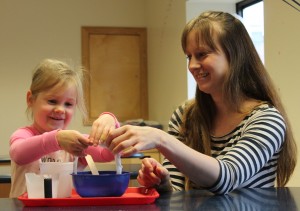
Research is highlighted at a Sciencenter Family Workshop where Cornell University students and ECC Lab researchers work with young participants. Photo credit Sciencenter
The Sciencenter and Cornell University partnership has been featured on CAISE’s Perspectives blog as part of its Spotlight series on university and museum partnerships. This is a follow-up to SENCER-ISE’s Spotlight post in March 2015.
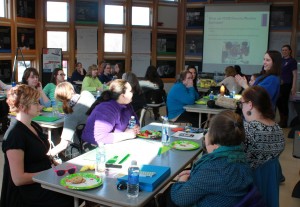
Sciencenter educators, Cornell University students and ECC Lab researchers conduct a workshop for Head Start teachers.
The Cornell University’s Early Childhood Cognition Lab and the Sciencenter are partnering to research early childhood learning and share their findings with parents, caregivers, and teachers. Continue reading to learn more about the partnership and its work.
The Sentinels Tackle Plastic Marine Debris
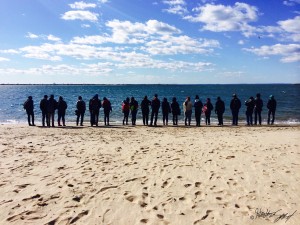
Sentinels gather at the shore to learn about coastal erosion.
Throughout the fall of 2014 the Sentinels of Shoreline change were at it again. Starting with NOAA’s marine debris field guide we tailored a data collection protocol focused on plastic debris. Plastic debris in in the oceans has been a growing issue figuratively and literally. The Great Atlantic Garbage Patch hundreds of miles off the northeast coast of America is getting bigger and more attention is being paid to this and other garbage patches in our oceans. Along shorelines plastics are continually being washed onto beaches and back to sea.
A group of NYC educators and their students, in collaboration with the National Parks Service and Brooklyn College, took surveys of the plastics found on shorelines around Jamaica Bay. Students were given an introduction on the impact that shoreline stabilization structures have had on our beaches. Shoreline structures are often built along beaches that are losing sand due to erosion. Structures such as groins, jetties and seawalls alter the effects of the oceans waves. Unfortunately, they can also cause down-coast erosion issues. Students were asked to think about how these issues might affect the debris that washed up on shore.
Working in groups, students catalogued the types and quantity of plastics they collected in an area of the beach, which was measured and tracked using GPS coordinates. Though some days were colder than others, all of the groups worked diligently and felt a real sense of accomplishment at the end of the day. The effects of their hard work were immediately visible in the beautifully cleaned shorelines.
Students also need to be able to understand local impacts before being able to grapple with global problems. So they were asked to take their survey skills home and find out how the plastic they collected on the beach related to them personally. By carefully tracking the plastic they used and discarded over a week students could then make underlying connections between themselves and the global plastic issue. Using the data they collected at home and on the beach some of the students from Brooklyn College presented posters at the Macaulay Honors College. A few entertaining PSA videos were also made to advocate recycling!
It is true the growing gyres of plastics in the ocean have been a concern for decades. However, quantifying how the local environment impacts them, and vice versa, is a continuing expedition. The Sentinels are continuing their work in the field to expand the database, including more shorelines. Ultimately this will help us to understand how the plastics we use end up in Jamaica Bay and the world’s oceans. Taking us all one step further in our quest to gain the knowledge required to begin finding solutions to our global plastic pollution problem.
To read more about the extent of plastics in our Oceans go to:
http://news.nationalgeographic.com/news/2010/03/100302-new-ocean-trash-garbage-patch/
Further reading on the effects of shoreline structures:
http://www.leovanrijn-sediment.com/papers/Coastalstructures2013.pdf
For more information on NOAA’s survey field guide please visit:
http://marinedebris.noaa.gov/sites/default/files/ShorelineFieldGuide2012.pdf
The students PSA videos can be seen here:
https://www.youtube.com/playlist?list=PLXj1sz0mReVA0ZOaNTEy-VLdTIsXTsbpM

